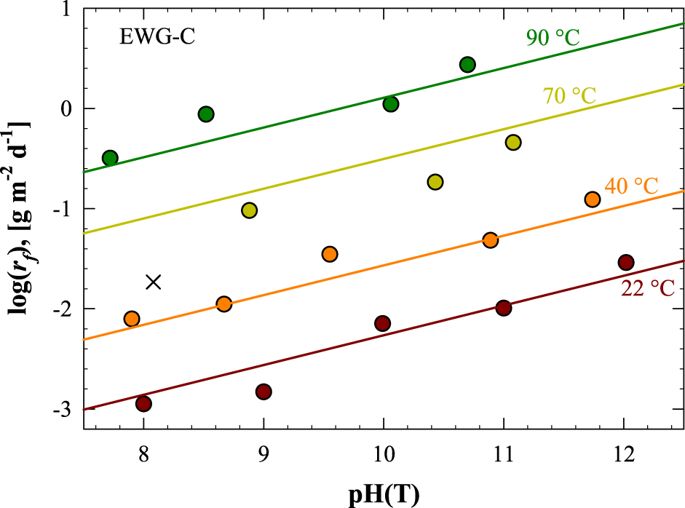npj Materials Degradation ( IF 5.1 ) Pub Date : 2018-08-06 , DOI: 10.1038/s41529-018-0042-5 John D. Vienna , James J. Neeway , Joseph V. Ryan , Sebastien N. Kerisit

|
Nuclear waste glasses dissolve at the forward dissolution rate (rf) in very dilute aqueous solutions, which can isolate the impact of the glass composition from solution feedback and alteration product effects. While it has long been known that pH and temperature (T) strongly impact rf, the impacts of glass composition have remained uncertain. In this work, rf data from 19 nuclear waste glasses were used with the aim of identifying the effect of glass composition on rf. The rf values were modeled as: rf = k010–ηpHexp(−Ea/RT), with k0, η, Ea, and R, respectively, being the intrinsic rate constant, pH coefficient, apparent activation energy, and gas constant. However, no predictive correlation could be established between the individual model parameters (log[k0], η, and Ea) and glass composition for the glasses considered in this study, an outcome that was attributed to the strong positive correlation between the log[k0] and Ea parameters. Therefore, a model was fitted directly to the combined rf from all 19 glasses. This approach showed that 90% of the variation in rf data could be accounted for solely by T and pH effects. Therefore, any composition effects must be relatively small. After normalizing for differences in pH and T, the only notable differences in rf between the glasses were found to correlate with variations in the fraction of glass forming tetrahedra contributed by tetrahedral boron, f([4]B), with an abrupt threshold at a high value of f([4]B) (~0.22), where higher rf are predicted with no discernable composition effects below the threshold.
中文翻译:

玻璃组成,pH和温度对玻璃正向溶解速率的影响
核废玻璃在很稀的水溶液中以正向溶解速率(r f)溶解,这可以将玻璃成分的影响与溶液反馈和改变产物的影响区分开。早已知道pH和温度(T)对r f有强烈影响,但玻璃成分的影响仍不确定。在这项工作中,使用了19个核废玻璃的r f数据,目的是确定玻璃成分对r f的影响。所述ř ˚F值建模为:- [R ˚F = ķ 0 10 -η pH值exp(-E a / RT),其中k 0,η,E a和R分别是固有速率常数,pH系数,表观活化能和气体常数。但是,在本研究中考虑的眼镜的各个模型参数(log [ k 0 ],η和E a)与玻璃成分之间没有建立预测相关性,这一结果归因于log之间的强正相关性[ k 0 ]和E a参数。因此,将模型直接拟合到所有19个眼镜的组合r f中。这种方法表明,r f数据中90%的变化可以仅由T和pH效应解释。因此,任何构图效果都必须相对较小。将pH和T的差异归一化后,发现玻璃之间的r f的唯一显着差异与由四面体硼f([4] B)贡献的玻璃形成的四面体分数的变化相关,突变阈值为f([4] B)(〜0.22)的较高值,其中较高预测r f不会低于阈值而没有明显的成分影响。



























 京公网安备 11010802027423号
京公网安备 11010802027423号